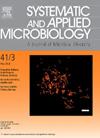Pyranulibacter aquaticus gen. nov., sp. nov., the first nitrate-reducing representative of the class Ignavibacteria from an Iturup well
IF 4.2
2区 生物学
Q2 BIOTECHNOLOGY & APPLIED MICROBIOLOGY
引用次数: 0
Abstract
A novel facultatively anaerobic moderately thermophilic bacterium, strain 4301-MeT was isolated from the well 13k on the Iturup Island (Kuril Islands, Russian Federation). Gram-stain-negative, motile rods were present singly, in pairs, rosettes, and aggregates, or formed biofilms. The strain grew optimally at 50–55 °C, pH 6.7–7.0 and 0.2–0.4 % NaCl. It did not require yeast extract for growth and utilized mono-, di- and polysaccharides (cellulose, starch, xanthan gum, locust bean gum, glucomannan, lichenan, amorphous chitin) as well as proteinaceous substrates (gelatin, peptone, beef and yeast extract). Growth under anaerobic conditions was observed in the presence and absence of external electron acceptors. Sulfur, thiosulfate, nitrate, arsenate, Fe-citrate, and ferrihydrite were reduced with acetate, or yeast extract as electron donors. The respiratory quinone was MK-7. Major cellular fatty acids were iso-C15:0, iso-C16:0, anteiso-C15:0, 3OH-C14:0, 3OH-C13:0. The size of the genome and genomic DNA G + C content of strain 4301-MeT were 3.34 Mb and 33 %, respectively. According to the 16S rRNA gene sequence and conserved protein sequences phylogenies, strain 4301-MeT represented a distinct lineage of the family Melioribacteraceae within the class Ignavibacteria. Based on phylogenomic analysis and phenotypic features, the novel isolate was assigned to a novel genus, for which the name Pyranulibacter gen. nov. is proposed. Strain 4301-MeT represents its type species Pyranulibacter aquaticus sp. nov. (=CGMCC 1.18061T = B-3822T = BIM B-2047T = UQM 41592T).
水生Pyranulibacter aquaticus gen. nov., sp. nov., Iturup井中发现的第一个硝酸盐还原伊格纳维细菌的代表
菌株4301-MeT是一种新型兼性厌氧适度嗜热细菌,分离自Iturup岛(Kuril群岛,俄罗斯联邦)的13k井。革兰氏染色阴性,可运动的杆呈单、双、莲座、聚集体或形成生物膜。菌株在50 ~ 55℃、pH 6.7 ~ 7.0和0.2 ~ 0.4% NaCl条件下生长最佳。它不需要酵母提取物来生长,利用单、双多糖和多糖(纤维素、淀粉、黄原胶、刺槐豆胶、葡甘露聚糖、地衣、无定形几丁质)以及蛋白质基质(明胶、蛋白胨、牛肉和酵母提取物)。在有无外部电子受体的情况下,观察了厌氧条件下的生长。硫、硫代硫酸盐、硝酸盐、砷酸盐、柠檬酸铁和水合铁用醋酸盐或酵母提取物作为电子供体进行还原。呼吸醌为MK-7。主要细胞脂肪酸为iso-C15:0、iso-C16:0、anteiso-C15:0、3OH-C14:0、3OH-C13:0。菌株4301-MeT的基因组大小为3.34 Mb,基因组DNA G + C含量为33%。根据16S rRNA基因序列和保守蛋白序列的系统发育,菌株4301-MeT代表了Ignavibacteria纲Melioribacteraceae的一个独特谱系。基于系统基因组分析和表型特征,该新分离物被归入一个新属,并被命名为Pyranulibacter gen. 11。菌株4301-MeT代表其类型种Pyranulibacter aquaticus sp. nov. (=CGMCC 1.18061T = B-3822T = BIM B-2047T = UQM 41592T)。
本文章由计算机程序翻译,如有差异,请以英文原文为准。
求助全文
约1分钟内获得全文
求助全文
来源期刊

Systematic and applied microbiology
生物-生物工程与应用微生物
CiteScore
7.50
自引率
5.90%
发文量
57
审稿时长
22 days
期刊介绍:
Systematic and Applied Microbiology deals with various aspects of microbial diversity and systematics of prokaryotes. It focuses on Bacteria and Archaea; eukaryotic microorganisms will only be considered in rare cases. The journal perceives a broad understanding of microbial diversity and encourages the submission of manuscripts from the following branches of microbiology:
 求助内容:
求助内容: 应助结果提醒方式:
应助结果提醒方式:


